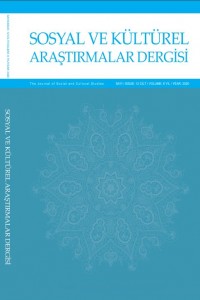Öz
Proje Numarası
ÖAP(İ)-2018/7
Kaynakça
- Akyürek, Salih ve Bilgiç, Sadi (2012). Ermenistan’da Türkiye ve Türk Algısı. BİLGESAM Raporu, Ankara.
- Alexander BUHMANN (2015). The constitution and effects of country images, Doctoral thesis, Faculty of Economics and Social Sciences at the University of Fribourg (Switzerland).
- Allport, Gordon W. (1979). The Nature of Prejudice. New York: Perseus Books.
- Anholt, Simon (2007). Places, Identity, image and reputacion. London: Palgrave Macmillan.
- Ayvazyan, Lianna (1999). Democracy, Press, Foreign Policy: Armenia’s Image in the American Press. Seminar proceedings, Yerevan.
- Bilgehan Gültekin (2005). Türkiye’nin Uluslararasi İmajinda Yükselen Değerler ve Eğilimler. Selçuk İletişim, pp. 126-140.
- Boulding, Kenneth (1969). National Image and International System. In James N. Rosenau (Ed.) International Politics and Foreign Policy (422-431). London: Collier Macmillan Inc.
- Bozkuş, Yıldız Deveci ve Arı, Eda Bekçi (2017). Güney Kafkasya Kökenli Öğrencilerin Türkiye’ye Gelmeden Önceki ve Geldikten Sonraki Türkiye Algılarının Değişimi. Bostancı Kırtasiye & Matbaacılık.
- Brewer, M. B., & Gaertner, S. L. (2001). Toward reduction of prejudice: Intergroup contact and social categorization. In A. Tesser, et al. (Eds.), Blackwell handbook of social psychology: Vol. 3. Intergroup processes (pp. 451–472). Oxford: Basil Blackwell.
- Büyüköztürk, Ş. (2002). Faktör Analizi: Temel Kavramlar ve Ölçek Geliştirmede Kullanımı. Kuram ve Uygulamada Eğitim Yönetimi, Vol.32(32), pp.470-483.
- Canan Yildiran, Duygu Özkan & Ozan Büyükyilmaz (2016). Yabancı Uyruklu Lisans Öğrencilerinin Durum Analizi: Karabük Üniversitesi. Uluslararası Bilimsel Araştırma Dergisi, pp.21-34.
- Faruk Levent & Özge Karaevli (2013). Uluslararası Öğrencilerin Eğitimine Yönelik Politikalar ve Türkiye İçin Öneriler. Journal of Educational Sciences, Vol.38, pp.97-117.
- Forbes, H. D. (1997). Ethnic conflict: Commerce, culture, and the contact hypothesis. New Haven, CT: Yale University Press.
- Ghazarian, P. G. (2016). Country Image and the Study Abroad Destination Choice of Students from Mainland China. Journal of International Students, Vol.6(3), pp. 700-711.
- Göver, İbrahim Hakan ve Yavuzer, Hasan (2015). Kayseri’de Öğrenim Gören Yabancı Uyruklu Öğrencilerin Kayseri, Türkiye ve İslam Algısı. Turkish Studies: International Periodical For The Languages, Literature and History of Turkish or Turkic, Vol.10/2. pp.1025-1050.
- Ihlanfeldt, K. R., & Scafidi, B. P. (2002). The neighbourhood contact hypothesis: Evidence from the Multicity Study of Urban Inequality. Urban Studies, 39, 619–641.
- Ingrid M.Martin Sevgin Eroglu (1993). Measuring a multi-dimensional construct: Country image. Journal of Business Research, Volume 28, Issue 3, Pages 191-210.
- Jan Melissen, (2005). The New Public Diplomacy Soft Power in International Relations, Macmilan press.
- Jervis Robert, (1970). The Logic of Images in International Relations. Columbia University Press. A Morningside Book.
- Karabayev, Baki ve Tutkun, Ömer F. (2001). Türk Cumhuriyetlerinden Gelen Öğrencilerin Türkiye Cumhuriyeti Vatandaşlarına Karşı Taşıdıkları Kalıp Yargılar. Bilig, Vol.18, pp.1-26.
- Kunczik Michael (1997). Images of Nations and International Public Relations. Lawrence Erlbaum Associates, Publishers. Mahwah, New Jersey.
- Kunczik, Michael (2002). ”Globalization: News media, images of nations and the flow of international capital with special reference to the role of rating agencies”, The Journal of International Communication. http://www.tandfonline.com/doi/abs/10.1080/13216597.2002.9751921 (39-79).
- Lianna Ayvazyan, (2007). The Image of Russia in Armenian Mass Media. Political Expertise (POLITEX), #3, (Conference on Political science and Political Processes in Russia and CIS Countries, in post-Soviet Realm, Eurasian Network of Political Studies, Moscow. http://www.politex.info/content/view/370/30/.
- Miller, N. (2002). Personalization and the promise of contact theory. Journal of Social Issues, 58(2), 387–410.
- Musa Top (2014). Türkiye’de Yükseköğrenim Gören Türkiye Burslusu Kuzey Afrikali Uluslararasi Öğrencilerin Arap Bahari Sonrasi Türk Diş Politikasi Algisi: 2002-2012. Yurtdışı Türkler ve Akraba Topluluklar Başkanlığı Uzmanlık Tezi.
- Mustafa Köylü (2001). O.M.Ü. İlahiyat Fakültesine Devam Eden Yabancı Uyruklu Öğrencilerin Fakülte Hakkındaki Düşünce, Sorun ve Beklentileri. Ondokuz Mayıs Üniversitesi İlahiyat Fakültesi Dergisi, Vol.12, pp. 131-153.
- Peter van Ham, The Rise of the Brand State:The Postmodern Politics of Image and Reputation (in Phil Taylor's Web Site).
- Pettigrew, T. F. (1998). Intergroup contact theory. Annual Review of Psychology, 49, 65–85.
- Pettigrew, Thomas F. & Tropp Linda R. (2005). Allport’s Intergroup Contact Hypothesis: Its History and Influence. In John F. Dovidio, Peter Glick, and Laurie A.
- Rudman (ed) “On the Nature of Prejudice Fifty Years after Allport”. Oxford: Blackwell Publishing.
- Pettigrew, T. F., & Tropp, L. R. (2000). Does intergroup contact reduce prejudice? Recent meta-analytic findings. In S. Oskamp (Ed.), Reducing prejudice and discrimination: Social psychological perspectives (pp. 93– 114). Mahwah, NJ: Lawrence Erlbaum.
- RICHARD K. HERRMANN, JAMES F. VOSS, TONYA Y. E. SCHOOLER AND JOSEPH CIARROCHI, (1997). Images in International Relations: An Experimental Test of Cognitive Schemata, International Studies Quarterly 41, 403–433.
- Saliu, Hasan (2013). “The image of a country, communication actors in educational exchanges” Thesis. Nr.1. Pristina: AAB College, ISSN: 1848-4298. (89-98).
- Simon Anholt (2007). Countries Must Earn Better Images through Smart Policy. Interviewee: Simon Anholt, Editor, Nation Branding and Public Diplomacy, Council of Foreign Relations (www.cfr.org).
- Simon Anholt (2013). Beyond the Nation Brand: The Role of Image and Identity in International Relations, Exchange: The Journal of Public Diplomacy, Vol. 2 Iss. 1, Art. 1.
- UNESCO. (2009). Global education digest 2009: Comparing education statistics across the world. Montreal: UNESCO Institute for Statistics.
- Valentina Feklyunina, (2009). National images in international realations putin’s russia and West, doctoral thesis, politic faculty of law business and social sciences university of Glasgow.
Öz
Ülkemizde yakın dönem içerisinde yabancı uyruklu öğrenci
sayısında önemli oranda artış olmuştur. Bu sayının büyük kısmı, eğitimlerini tamamladığında
ülkemizden ayrılan geçici bir nüfus oluşumunu temsil etse de sürecin sadece
kısa vadede değil uzun vadede de ülkemiz açısından birtakım sonuçları olabilmektedir.
Ülkemizde belli bir süre kaldıktan sonra kendi ülkelerine veya başka ülkelere
taşınan yabancı öğrencilerde oluşan Türkiye imajı uzun vadeli sonuçların en
önemli etkenlerinden bir tanesidir. Bu bağlamda, ülkemize gelmeden önce ve
geldikten sonra yabancı öğrencilerdeki Türkiye imajlarının nasıl olduğunu
tespit etmek elzem olmaktadır. Mevcut çalışmanın amacı, Bursa Uludağ
Üniversitesi’nde eğitim almakta olan yabancı uyruklu öğrencilere anket yoluyla
ulaşıp, “Yabancı öğrenciler üniversitemizde eğitim almaya başladıktan sonra
kendilerindeki Türkiye imajında bir değişiklik oldu mu, olduysa bunun nedenleri
nelerdir?” sorularına karşılık bulmaya çalışmaktır. Buradan elde edilen verilere,
gerek hâlihazırda ülkemizde bulunan gerekse ileride gelecek olan yabancı
uyruklu öğrencilerdeki Türkiye imajını daha da iyileştirmek amacıyla
geliştirilecek politikaların oluşturulmasında somut kaynak olarak
başvurulabilecektir.
Anahtar Kelimeler
Destekleyen Kurum
Bursa Uludağ Üniversitesi Bilimsel Araştırma Projeleri Komisyonu
Proje Numarası
ÖAP(İ)-2018/7
Kaynakça
- Akyürek, Salih ve Bilgiç, Sadi (2012). Ermenistan’da Türkiye ve Türk Algısı. BİLGESAM Raporu, Ankara.
- Alexander BUHMANN (2015). The constitution and effects of country images, Doctoral thesis, Faculty of Economics and Social Sciences at the University of Fribourg (Switzerland).
- Allport, Gordon W. (1979). The Nature of Prejudice. New York: Perseus Books.
- Anholt, Simon (2007). Places, Identity, image and reputacion. London: Palgrave Macmillan.
- Ayvazyan, Lianna (1999). Democracy, Press, Foreign Policy: Armenia’s Image in the American Press. Seminar proceedings, Yerevan.
- Bilgehan Gültekin (2005). Türkiye’nin Uluslararasi İmajinda Yükselen Değerler ve Eğilimler. Selçuk İletişim, pp. 126-140.
- Boulding, Kenneth (1969). National Image and International System. In James N. Rosenau (Ed.) International Politics and Foreign Policy (422-431). London: Collier Macmillan Inc.
- Bozkuş, Yıldız Deveci ve Arı, Eda Bekçi (2017). Güney Kafkasya Kökenli Öğrencilerin Türkiye’ye Gelmeden Önceki ve Geldikten Sonraki Türkiye Algılarının Değişimi. Bostancı Kırtasiye & Matbaacılık.
- Brewer, M. B., & Gaertner, S. L. (2001). Toward reduction of prejudice: Intergroup contact and social categorization. In A. Tesser, et al. (Eds.), Blackwell handbook of social psychology: Vol. 3. Intergroup processes (pp. 451–472). Oxford: Basil Blackwell.
- Büyüköztürk, Ş. (2002). Faktör Analizi: Temel Kavramlar ve Ölçek Geliştirmede Kullanımı. Kuram ve Uygulamada Eğitim Yönetimi, Vol.32(32), pp.470-483.
- Canan Yildiran, Duygu Özkan & Ozan Büyükyilmaz (2016). Yabancı Uyruklu Lisans Öğrencilerinin Durum Analizi: Karabük Üniversitesi. Uluslararası Bilimsel Araştırma Dergisi, pp.21-34.
- Faruk Levent & Özge Karaevli (2013). Uluslararası Öğrencilerin Eğitimine Yönelik Politikalar ve Türkiye İçin Öneriler. Journal of Educational Sciences, Vol.38, pp.97-117.
- Forbes, H. D. (1997). Ethnic conflict: Commerce, culture, and the contact hypothesis. New Haven, CT: Yale University Press.
- Ghazarian, P. G. (2016). Country Image and the Study Abroad Destination Choice of Students from Mainland China. Journal of International Students, Vol.6(3), pp. 700-711.
- Göver, İbrahim Hakan ve Yavuzer, Hasan (2015). Kayseri’de Öğrenim Gören Yabancı Uyruklu Öğrencilerin Kayseri, Türkiye ve İslam Algısı. Turkish Studies: International Periodical For The Languages, Literature and History of Turkish or Turkic, Vol.10/2. pp.1025-1050.
- Ihlanfeldt, K. R., & Scafidi, B. P. (2002). The neighbourhood contact hypothesis: Evidence from the Multicity Study of Urban Inequality. Urban Studies, 39, 619–641.
- Ingrid M.Martin Sevgin Eroglu (1993). Measuring a multi-dimensional construct: Country image. Journal of Business Research, Volume 28, Issue 3, Pages 191-210.
- Jan Melissen, (2005). The New Public Diplomacy Soft Power in International Relations, Macmilan press.
- Jervis Robert, (1970). The Logic of Images in International Relations. Columbia University Press. A Morningside Book.
- Karabayev, Baki ve Tutkun, Ömer F. (2001). Türk Cumhuriyetlerinden Gelen Öğrencilerin Türkiye Cumhuriyeti Vatandaşlarına Karşı Taşıdıkları Kalıp Yargılar. Bilig, Vol.18, pp.1-26.
- Kunczik Michael (1997). Images of Nations and International Public Relations. Lawrence Erlbaum Associates, Publishers. Mahwah, New Jersey.
- Kunczik, Michael (2002). ”Globalization: News media, images of nations and the flow of international capital with special reference to the role of rating agencies”, The Journal of International Communication. http://www.tandfonline.com/doi/abs/10.1080/13216597.2002.9751921 (39-79).
- Lianna Ayvazyan, (2007). The Image of Russia in Armenian Mass Media. Political Expertise (POLITEX), #3, (Conference on Political science and Political Processes in Russia and CIS Countries, in post-Soviet Realm, Eurasian Network of Political Studies, Moscow. http://www.politex.info/content/view/370/30/.
- Miller, N. (2002). Personalization and the promise of contact theory. Journal of Social Issues, 58(2), 387–410.
- Musa Top (2014). Türkiye’de Yükseköğrenim Gören Türkiye Burslusu Kuzey Afrikali Uluslararasi Öğrencilerin Arap Bahari Sonrasi Türk Diş Politikasi Algisi: 2002-2012. Yurtdışı Türkler ve Akraba Topluluklar Başkanlığı Uzmanlık Tezi.
- Mustafa Köylü (2001). O.M.Ü. İlahiyat Fakültesine Devam Eden Yabancı Uyruklu Öğrencilerin Fakülte Hakkındaki Düşünce, Sorun ve Beklentileri. Ondokuz Mayıs Üniversitesi İlahiyat Fakültesi Dergisi, Vol.12, pp. 131-153.
- Peter van Ham, The Rise of the Brand State:The Postmodern Politics of Image and Reputation (in Phil Taylor's Web Site).
- Pettigrew, T. F. (1998). Intergroup contact theory. Annual Review of Psychology, 49, 65–85.
- Pettigrew, Thomas F. & Tropp Linda R. (2005). Allport’s Intergroup Contact Hypothesis: Its History and Influence. In John F. Dovidio, Peter Glick, and Laurie A.
- Rudman (ed) “On the Nature of Prejudice Fifty Years after Allport”. Oxford: Blackwell Publishing.
- Pettigrew, T. F., & Tropp, L. R. (2000). Does intergroup contact reduce prejudice? Recent meta-analytic findings. In S. Oskamp (Ed.), Reducing prejudice and discrimination: Social psychological perspectives (pp. 93– 114). Mahwah, NJ: Lawrence Erlbaum.
- RICHARD K. HERRMANN, JAMES F. VOSS, TONYA Y. E. SCHOOLER AND JOSEPH CIARROCHI, (1997). Images in International Relations: An Experimental Test of Cognitive Schemata, International Studies Quarterly 41, 403–433.
- Saliu, Hasan (2013). “The image of a country, communication actors in educational exchanges” Thesis. Nr.1. Pristina: AAB College, ISSN: 1848-4298. (89-98).
- Simon Anholt (2007). Countries Must Earn Better Images through Smart Policy. Interviewee: Simon Anholt, Editor, Nation Branding and Public Diplomacy, Council of Foreign Relations (www.cfr.org).
- Simon Anholt (2013). Beyond the Nation Brand: The Role of Image and Identity in International Relations, Exchange: The Journal of Public Diplomacy, Vol. 2 Iss. 1, Art. 1.
- UNESCO. (2009). Global education digest 2009: Comparing education statistics across the world. Montreal: UNESCO Institute for Statistics.
- Valentina Feklyunina, (2009). National images in international realations putin’s russia and West, doctoral thesis, politic faculty of law business and social sciences university of Glasgow.
Ayrıntılar
| Birincil Dil | Türkçe |
|---|---|
| Bölüm | Makaleler |
| Yazarlar | |
| Proje Numarası | ÖAP(İ)-2018/7 |
| Yayımlanma Tarihi | 21 Haziran 2020 |
| Yayımlandığı Sayı | Yıl 2020 Cilt: 6 Sayı: 12 |
Kaynak Göster
DİZİNLEME & ÖZETLEME & ARŞİVLEME
Sosyal ve Kültürel Araştırmalar Dergisi (SKAD)'da yayınlanan makaleler Creative Commons Atıf-GayriTicari 4.0 Uluslararası Lisansı ile lisanslanmıştır. SKAD bilginin paylaşımı için Açık Erişim Politikasına uymaktadır.



